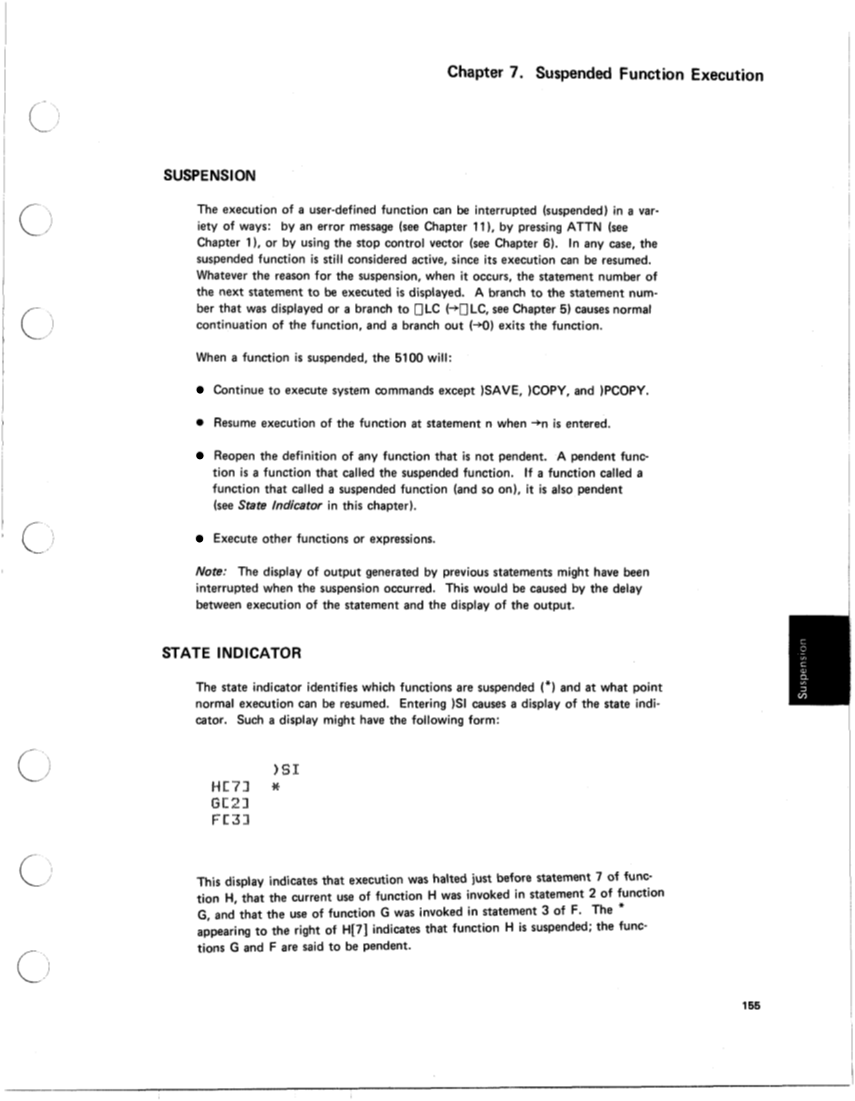When executing the function TRACE, the argument must be entered in single
quotes. For example:
:; 'r' 1:: v E: f: 2 3 14. 4
::; 'I'
Ef v E c 3 ::I 6
s 'r' I, v E: E: '4. ::I 8
:; 'i' 1:: v li. I:: 5 :3 2 0
'r'hs."E:VE:.. , ()
?3 7' E v 1:: 2
Each statement of function
STEVE has been traced.
2 0
Stop Control
Stop control is used to stop the execution of a function just before specified
statements. At each stop, the function name and statement number of the state-
ment to be executed next is displayed. The statements are specified by a stop
vector. The format of the stop control function is SA STEVEW, where STEVE
is the name of the function and I is the vector specifying the statements. After
the stop, the system is in the suspended state (see Chapter 7); execution is
resumed by entering +nLC (see Chapter 5). SASTEVE+tO (STEVE is the
function name) must be entered to discontinue the stop control function.
Stop control can be set by statements within a function. These statements
initiate halts when a variable contains a certain value. For example,
SA STEVE+4xN>8 means stop before statement 4 in function STEVE when
N
is greater than 8.
Trace control and stop control can both be used in the same user-defined
function.
quotes. For example:
:; 'r' 1:: v E: f: 2 3 14. 4
::; 'I'
Ef v E c 3 ::I 6
s 'r' I, v E: E: '4. ::I 8
:; 'i' 1:: v li. I:: 5 :3 2 0
'r'hs."E:VE:.. , ()
?3 7' E v 1:: 2
Each statement of function
STEVE has been traced.
2 0
Stop Control
Stop control is used to stop the execution of a function just before specified
statements. At each stop, the function name and statement number of the state-
ment to be executed next is displayed. The statements are specified by a stop
vector. The format of the stop control function is SA STEVEW, where STEVE
is the name of the function and I is the vector specifying the statements. After
the stop, the system is in the suspended state (see Chapter 7); execution is
resumed by entering +nLC (see Chapter 5). SASTEVE+tO (STEVE is the
function name) must be entered to discontinue the stop control function.
Stop control can be set by statements within a function. These statements
initiate halts when a variable contains a certain value. For example,
SA STEVE+4xN>8 means stop before statement 4 in function STEVE when
N
is greater than 8.
Trace control and stop control can both be used in the same user-defined
function.









































































































































































































































